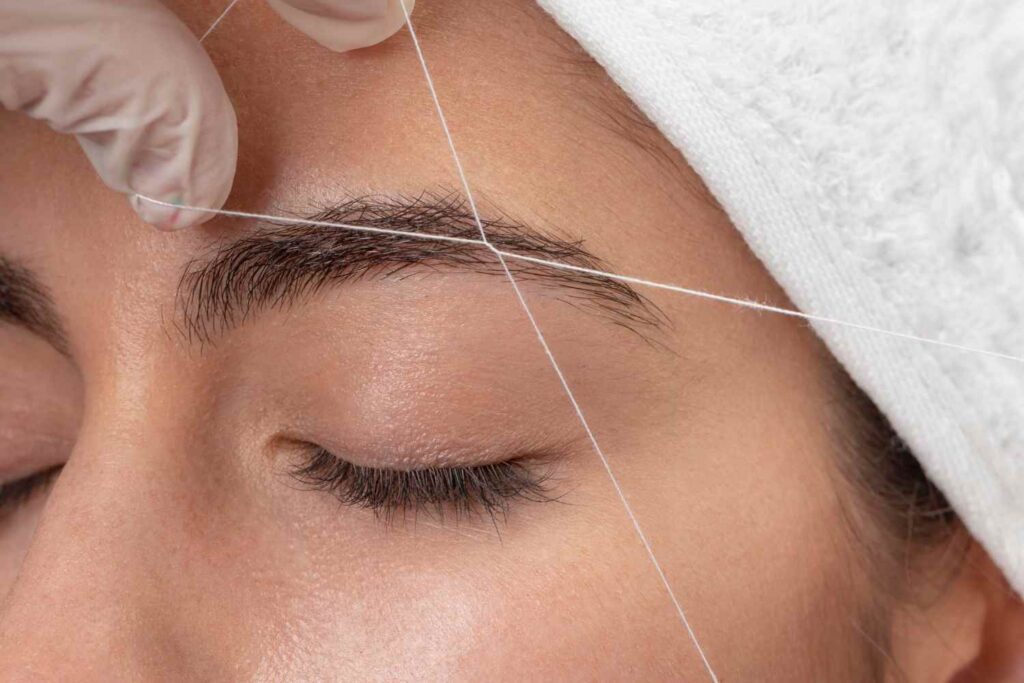From Fuzzy to Flawless: Tame Facial Hair with Top Tips & Tricks
:max_bytes(150000):strip_icc()/womenfacialhair-v1-primary-7bc4c48f5e514ba8828ee37018b1f1fd.jpg)
If you struggle with managing facial hair, you're not alone. Many people face this challenge and may feel frustrated with the various hair removal methods available. However, one option has become increasingly popular in recent years: laser hair removal. In this article, we will explore why facial hair can be challenging to manage and discuss the basics of laser hair removal for the face.
Why facial hair can be challenging to manage
Facial hair can pose several challenges when it comes to removal. For example:
- It can be thick and coarse, making it difficult to shave without causing irritation or razor burn.
- Hair growth can be uneven, making it difficult to maintain a smooth appearance.
- Some people may experience ingrown hairs or folliculitis (inflammation of the hair follicles) due to hair removal efforts.
These challenges can lead to frustration and a desire for a more effective solution.
Overview of laser hair removal for the face
Laser hair removal is a non-invasive procedure that uses a concentrated beam of light to target and destroy hair follicles. The procedure uses thermal energy to damage the hair follicle, inhibiting future hair growth in that area.
There are several benefits to using laser hair removal for facial hair, including:
- It is a long-term solution. Unlike shaving or waxing, which require frequent maintenance to keep hair at bay, laser hair removal can provide long-lasting results after only a few sessions.
- It can be customized to individual needs. Depending on hair colour, skin type, and other factors, your technician can adjust the laser settings to provide the most effective treatment.
- It is relatively painless. While you may feel discomfort during the procedure, most people report it as tolerable.
Overall, laser hair removal is an effective option for those looking to manage facial hair in a more long-term and efficient way. If you're interested in trying the procedure, consult a reputable provider to discuss your options and expectations.
Types of Facial Hair Removal Techniques
There are various hair removal techniques if you're struggling with managing your facial hair. Each method has pros and cons, so it's essential to understand the differences to make an informed decision. This article will explore the most popular facial hair removal methods.
Shaving
Shaving is the most common and inexpensive hair removal method. It involves using a razor to cut hair at the skin's surface. While shaving can be a quick and painless way to remove facial hair, it can cause razor burns, nicks, and cuts. Additionally, hair grows back quickly, often within hours or days, and can give coarse stubble and ingrown hairs.
Waxing
Waxing entails applying wax to the skin and pulling hair out by the roots. The process can be done at home or by a professional. Waxing results can last longer than shaving, from a few days to weeks. However, the process can be painful, and people with sensitive skin may experience redness and irritation after the procedure.
Threading
Threading is a traditional hair removal technique that uses a twisted cotton thread to catch and pull facial hair out. The procedure is precise and can be done on small areas like the eyebrows, upper lip, and chin. Threading is gentler than waxing but can still cause discomfort and redness.
Laser hair removal
Laser hair removal is a non-invasive procedure that uses a concentrated beam of light to destroy hair follicles. It is an effective and long-term solution to manage facial hair growth. Unlike other hair removal methods, laser hair removal provides long-lasting results after a few sessions. It is a relatively painless procedure, with most people reporting only mild discomfort. Although laser hair removal can be more expensive than other methods, the investment can be worth it in the long run.
Now that you know different techniques to manage facial hair, choose the one that works best for you. If you're unsure which procedure to choose, consult a professional to help you make an informed decision.

Benefits of Laser Hair Removal for Facial Hair Management
You're not alone if you're struggling with managing your facial hair. Fortunately, various hair removal techniques are available, each with pros and cons, but laser hair removal stands out for several reasons. In this article, we will explore the benefits of laser hair removal for facial hair management.
Precise and targeted hair removal
One of the most significant benefits of laser hair removal is its precision. The concentrated beam of light used in laser hair removal targets hair follicles, leaving the surrounding skin undamaged. This targeting also makes laser hair removal ideal for small areas like the upper lip, chin, and eyebrows, where other methods like shaving and waxing can be difficult to use without irritating.
Long-lasting results
Laser hair removal offers long-lasting results compared to other hair removal methods. After a few sessions, most patients experience a significant reduction in hair growth in the treated area. Unlike shaving, waxing, and threading, which require frequent maintenance, laser hair removal sessions must be repeated once or twice a year to maintain results, making it a cost-effective solution in the long run.
No more irritation or ingrown hairs
While shaving and threading can cause razor burns, nicks, cuts, and redness, waxing can cause irritation, redness, and ingrown hairs. However, laser hair removal is gentle on the skin, with most patients only experiencing mild discomfort during the procedure. Furthermore, it reduces the likelihood of ingrown hairs, which leads to clear and smooth skin.
If you're looking for a low-maintenance, long-term solution to facial hair management, laser hair removal could be the answer. Its precision, long-lasting results, and gentle approach to hair removal make it an excellent option for those struggling to maintain their facial hair. Consult a professional to determine if laser hair removal is the right choice.

Preparing for Laser Hair Removal
Are you tired of dealing with facial hair and looking for a long-term solution? Laser hair removal may be the answer you're looking for, but before you book your appointment, you must prepare properly. Here are some essential tips to help you prepare for your laser hair removal session.
Consultation with a licensed professional
Before scheduling your laser hair removal session, it's important to consult with a licensed professional. During the consultation, they will assess your skin and hair type, recommend the number of sessions needed, and answer any questions you may have. This step ensures that laser hair removal is safe and effective for you.
Avoiding sun exposure and certain medications
Avoid prolonged sun exposure and tanning beds one to two weeks before your laser hair removal session. Sun exposure can make your skin more sensitive, and the laser can cause burns or discolouration in tanned skin. Also, avoid medications that can increase your skin's sensitivity, such as antibiotics or topical creams.
Shaving the treatment area
Before your laser hair removal session, shave the treatment area a day or two beforehand. Shaving removes the visible hair above the surface, allowing the laser to target the hair follicle effectively. Avoid waxing or plucking, as these methods remove hair from the root, making it difficult for the laser to target the follicles.
You can ensure safe and effective results by properly preparing for your laser hair removal session. A licensed professional, avoiding sun exposure and medications, and shaving the treatment area are all critical steps in preparing for your session. Say goodbye to unwanted facial hair and hello to smooth, clear skin with laser hair removal.
During the Laser Hair Removal Treatment
Congratulations on scheduling your laser hair removal session! Now that you’ve prepared for it, it's time to discuss what to expect during the treatment. Don't worry, it’s a straightforward process, but you should know a few things.
Wearing protective eyewear
Before your laser hair removal session begins, your technician will provide you with protective eyewear to shield your eyes from the laser. This ensures the safety of your eyes since the laser beam can damage them if exposed.
Application of cooling gel
Once your protective gear is on, the technician will apply a cooling gel to the treatment area. The gel will soothe and protect your skin from the laser's heat. It also helps the laser penetrate your skin more effectively, making the treatment more comfortable and efficient.
Pulsed light technology
The technician will use pulsed light technology to target the hair follicles in the treatment area. The laser emits a beam of light, which heats the hair and damages the follicle. This heat stops the hair from growing back, and after a few treatments, the hair follicle will become dormant. The treatment time will depend on the size of the area being treated, but most sessions take between 30 minutes to an hour.
During your laser hair removal treatment, you'll wear protective eyewear, apply cooling gel to the treatment area, and receive treatment using pulsed light technology. Most importantly, the treatment is safe, efficient, and designed for smooth and clear skin.

After the Laser Hair Removal Treatment
Congratulations on completing your laser hair removal session! The treatment may be over, but there are still a few things you should keep in mind to ensure proper aftercare. Here's what to expect:
Applying soothing creams and lotions
Your skin may feel mildly irritated or sensitive after the treatment. Apply a soothing cream or lotion to the treated area to ease discomfort. Aloe vera gel or a fragrance-free moisturizer can do wonders for your skin.
Avoiding sun exposure and hot environments
Your skin will be more sensitive than usual after the laser hair removal treatment, so protecting it from the sun's harmful rays is essential. Avoid sun exposure and hot environments such as saunas, hot tubs, and steam rooms for the next few days.
Staying hydrated
Drinking plenty of water is vital after any laser treatment. Hydration will not only help reduce any inflammation or redness but also aid in the healing process. Aim for at least eight glasses of water a day.
Remember, the aftercare is just as important as the treatment itself. By following these tips, you can ensure that your skin stays healthy and smooth. If you have any questions or concerns, don't hesitate to contact your technician. Until then, enjoy your newly hair-free skin!

Maintenance and Follow-Up Treatments
Congratulations on completing your laser hair removal treatment! Understandably, you want to maintain your newly hair-free skin. Here's what you need to remember for maintenance and follow-up treatments.
How often to schedule follow-up treatments
The number of sessions needed for laser hair removal varies depending on the individual's hair type and skin tone. Typically, four to six sessions are necessary to achieve the desired results. It's recommended to schedule your follow-up sessions every four to six weeks, depending on the rate of hair regrowth in the treated area.
Tips for maintaining hair-free results
To maintain the hair-free results of your laser hair removal treatment, follow these tips:
- Avoid plucking or waxing: After the treatment, avoid plucking or waxing the treated area to avoid irritating the skin. If needed, you can gently shave the area.
- Stay out of the sun: Always wear sunscreen to protect your skin from harmful UV rays. Exposure to the sun can cause hyperpigmentation, which could be difficult to treat.
- Exfoliate regularly: Between laser hair removal sessions, exfoliate your skin regularly to remove dead skin cells. This helps prevent ingrown hairs and keeps your skin smooth and healthy.
Remember, laser hair removal is a long-term solution for hair removal, but maintenance is still necessary to keep hair regrowth at bay. You can enjoy long-lasting hair removal results by following the above tips and scheduling periodic follow-up treatments! If you have any questions or concerns, don't hesitate to contact your technician.
